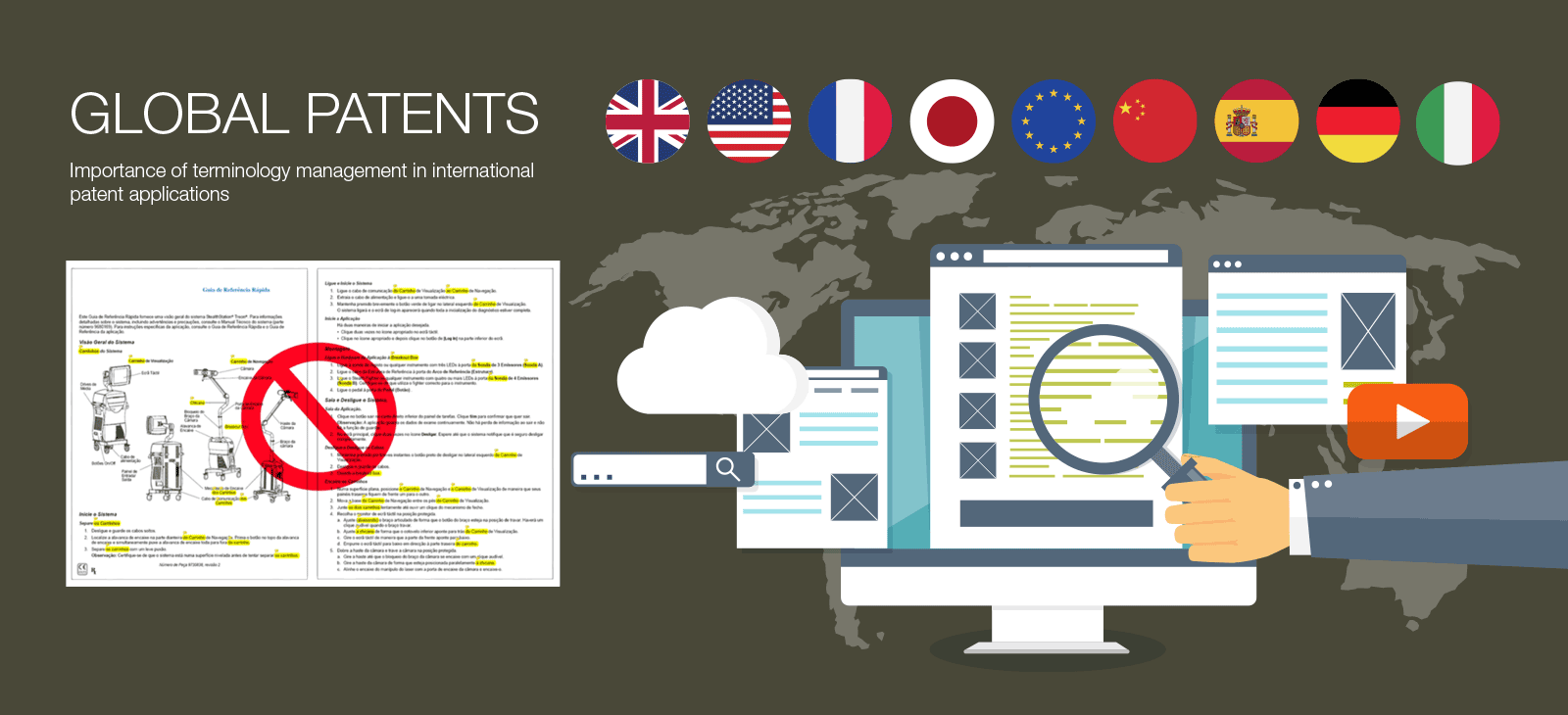Patent Translation and Terminology Management
- Carl Yao
- March 15, 2016
- 6,425 views

In today’s global economy, securing international patents in multiple jurisdictions is an important business requirement for multinational companies in both R&D and product distribution. As such, these patents must be accurately translated to achieve the same high level of protection for a company’s intellectual property in international markets. Failure to do so can lead to multi-million dollar losses that might take years to recover.
Unlike other types of translation, legal language is full of technical jargon with precise definitions and contextual uses strictly defined by law. Accurate translation of the invention summary, data sheet, specifications, and other supporting documents along with all the technical terminology is critical for successful international patent applications and any situation that might arise in the future, such as potential patent infringement litigation.
Importance of terminology management in patent applications
The consequence of a single mistranslated term in a patent application can be damaging, potentially leading to a prolonged and costly process in order to correct the mistake and reissue the patent. Such was the case faced by Japanese Kanzaki Paper Mfg. Co., Ltd., with its US patent No. 3,244,730, which involved the manufacturing process of three phthalide compounds. After discovering the mistranslations of key terms in their patented manufacturing process—including the translation of “nitric acid” to “nitrous acid” and misusing “ferrous oxide” in place of “iron”—the company filed to reissue the patent with the corrected terminology. However, in 1966, four years after the reissuance request, the US Patent Office finally denied the request. The US Patent Office’s decision was based on the following argument “changes of ‘nitrous’ to ‘nitric’ and ‘ferrous oxide’ to ‘iron’…are deemed to be drawn to new matter… [And] applicants are not permitted to add new matter in order to disclose what they initially intended even though it can be shown that it was part of the original invention and had been inadvertently presented from the original specification.” In light of this decision, Kanzaki Paper filed an appeal with the United States Court of Customs and Patents Appeals. Upon reviewing the appeal in 1971—11 years after the initial patent application—the previous ruling was eventually reversed by the Appeals Court. Although the error might have seemed trivial to translators at the time, it ended up costing the company an additional 11 years to obtain the patent for which they initially applied. Setting the legal costs aside, with typical US-issued patents having a 25-year patent life, waiting 11 years to correct a mistranslation in order to make the patent legal is clearly detrimental to any business plan.
Although this case is quite dated, patent mistranslation issues still persist today. With an ever increasing emphasis placed on patents to protect companies’ intellectual property outside of home markets, combined with the growing trend of globalized R&D operations, the ability to efficiently and accurately manage product terminology in various languages is crucial to streamlining simultaneous patent application processes across multiple markets.
When it comes to patent translation, key terms and important terminology should not be left up to a linguist or even an end user to decide its definition. Clearly defining terminology with accurate definitions is a central component of maintaining quality multilingual translation. Additionally, it’s just as—if not more—important to maintain a complete record of creation: who created the source term and when, the name of the reviewer(s), what revisions were made and by whom, who performed the translation, and who approved the source term as well as the translation. In order to abide by legal and regulatory compliance processes, a paper trail must be established. While accuracy will always be the number one concern for translators, consistency is also a major factor that should be taken into consideration, especially when multiple parties are involved in the translation of a single document. Without establishing standardized definitions for terms with multiple interpretations (for example, block has multiple interpretations: to prevent something from functioning, a large amount of securities being held for trade, a text block, a crown block in a drilling bit, and so on), every translation team or individual translation team member will be required to spend valuable time determining the right meaning for the right usage by performing terminology research. With a typical translation project consisting of tens or even hundreds of these types of words, managing them will create a significant drain on resources for the translation unit or linguists themselves.
Managing terminology translation in patent infringement disputes
The 1996 Markman v. Westview Instruments, Inc. case determined that for all subsequent patent infringement cases, a judge (not a jury) would determine the final interpretation of the language used in the patent claim. Therefore, during the pretrial period of patent infringement cases in the US, a Markmam hearing is held by a judge to review and assess submitted evidence in order to establish the appropriate meaning of key terminology used in the patent claim.
Markman v. Westview Instruments, Inc.
On April 23, 1996, Markman v. Westview Instruments, Inc. showcased the importance of terminology in all patent infringement disputes. The case began when Herbert Markman brought a patent infringement suit against Westview Instruments regarding his US Patent No. 33,054. The patent in question was for an inventory control system that tracks articles of clothing in the cleaning and sorting process for dry cleaning businesses. The patent describes the system as “capable of monitoring and reporting upon the status, location, and throughput of inventory in an establishment.” Westview’s counter-argument stated their system was designed to only track the invoices and transactions of customers in the dry cleaning process, not the actual clothes themselves. The case was first heard in the US District Court in 1991, where the jury found basis for infringement in Markman’s claim; however, the district court granted Westview’s request for a deferred motion. This decision was based on the interpretation of the term “inventory” in Markman’s patent. In the views of the court, the term “inventory” encompasses “both cash inventory and the actual physical inventory of articles of clothing.” Under this interpretation, Westview’s system had not infringed Markman’s patent because it was incapable of tracking the articles of clothing throughout the cleaning process and generating reports about their status and location.
As a result of the deferred motion, Markman appealed and the case was presented before the US Court of Appeals in 1995, based on the argument that the District Court was in the wrong to substitute its own definition of the term “inventory” with the jury’s interpretation. However, this argument was rejected by the appeals court, and the case was brought before the US Supreme Court in 1996. Upon reviewing the case and previous judgments from lower courts, the Supreme Court ruled in a unanimous decision to uphold “the interpretation of claim terms to be the exclusive province of the court,” thus setting the precedent of Markman hearings for patent infringement suits.
Although it is part of the pretrial hearing, a Markman hearing emphasizes the importance of accurately defining key terminology in patent infringement cases, especially because the outcome of the case can be heavily influenced by a single judge’s interpretation. Additionally, in a Markman hearing, the evidence reviewed by the judge usually involves both intrinsic evidence such as the patent documentation, as well as external evidence such as expert opinions. Therefore, patent application documents play a crucial role in the evidence used by the judge to determine how key terminologies are defined. Submitting a list of terms and definitions created in the initial stages of the patent application has the potential to hold serious weight when reviewed by a judge determining how the terminology in the patent is to be interpreted. With a detailed review and revision history for each term and definition, terminology management systems play an important role and are perfectly positioned to provide the information needed during the pretrial Markman hearing.
Employing technology tools to ensure patent translation accuracy
Even though terminology translation accuracy is critical for international patent applications and infringement lawsuits, effectively managing terminology translation remains a challenging task. Specifically, quality patent translation requires viable solutions for all of the following challenges:
- Collaboration: Terminology management is a highly collaborative process that involves the participation of functional teams across many different departments and from locations around the world.
- Paper trail: Tracking complete terminology change history, from source term creation and use approval to translation, review, and translation signoff, can be especially tough when placed on a global scale across multiple languages.
- Project Management: Tracking and implementing changes across multiple languages, as well as task delegation, can be notoriously difficult in traditional terminology management models.
- Administration: Controlling who can view, access, and modify a given termbase cannot be efficiently executed in a spreadsheet-based model.
There are a number of traditional terminology management systems available, but few are able to manage all of the above challenges efficiently. Products such as CSOFT’s TermWiki Pro offers a new approach to a traditionally challenging situation. In addition to employing the wiki-based technology for maintaining detailed change records to track the creation, review, translation, and approval of each term, TermWiki Pro supports online collaboration among subject matter experts and translators from the moment users sign up.
A wiki approach to terminology management and patent translation
Incorporating a wiki into your company’s content management strategies will ensure accurate and speedy translation of all types of content across multiple markets in addition to patent applications. A wiki approach is designed to bridge the accuracy and consistency gap created during the translation process. The use of a single standardized database of approved terminology promotes consistency across translators and languages. In using the this method, terminology is the first thing translated and reviewed, prior to the actual content translation process. This method allows the term to be properly translated, reviewed, and approved before it is shared and used for translating product content into the target languages.
The key to turning a newly sourced word into a term that has been properly translated and reviewed relies on the collaboration efforts of multiple parties. Therefore, centralizing this process is essential for users to collaborate, control, and develop the terms that are relevant to their own unique needs.
With a robust user management system, a tool like TermWiki Pro allows administrators to provide access and grant specific permissions to users; that is, it enables project managers to control which team members can access which glossaries and determine which areas can be modified by which users. In addition to giving an organization the ability to control sensitive content from internal viewers, administrators can reduce the potential for human error by limiting editing rights and only allowing certain parties to edit specifics terms. Even if an error were to occur, project managers are easily able to trace the origin of a particular mistake. Additionally, project managers can roll back changes to a previous version.
Global enterprises rely on tools to manage patent terminology on the cloud securely
TermWiki Pro is a secure platform designed for global businesses to manage legal terminology and technical jargons for better accuracy and consistency across languages. Throughout each step of TermWiki Pro’s design process, an emphasis was placed on usability. Usability combines an intuitive environment with wiki-based technology to streamline terminology management processes. TermWiki Pro delivers a single-click solution to the import/export process of terms to seamlessly integrate its data with other CMS systems and facilitate compliance with relevant ISO standards in terminology management through its data categorization structure.
One of the key strengths of TermWiki Pro is that it keeps a detailed paper trail to track all revisions and approval records throughout a term’s lifecycle. Not only does this reduce the risk of using incorrect or less-than-ideal terms in the patent application process, but it also offers protection and verification for any potential disputes that might arise in the future. TermWiki Pro can simultaneously support multiple customized workflows as well as project-based terminology assembly for specific products or business units, giving organizations flexibility in their terminology management processes. Important terms can be validated by several parties, while other terms can be integrated into a more streamlined process to automate terminology approval and sign off. The workflows are supported by automatic notifications, as well as the My Tasks page, which lists all tasks required of a particular user on one page. In turn, project managers can keep track of all progress through workflow and activity reports.
Additional functionalities included in the TermWiki Pro family of products include integrated supplementary services such as Term Assist and TermWiki Widget. Term Assist is a desktop app that allows source content authors and translators to instantly search terms and definitions from their own TermWiki Pro user accounts. TermWiki Widget allows users to display selected terms from their own TermWiki Pro database, on their own site, enabling readers to instantly access definitions for complex terminologies on the same page as the original content. No more need for copy/paste and external translation applications.
Conclusion
Accurately translating your patents to secure the same high level of intellectual property protection internationally as your company enjoys locally is an important internationalization practice that can help companies gain competitive advantage in global markets. Key to this effort is a systematic approach to the management of important product terminology across all major languages and functional departments. Wikibased technology provides an ideal platform that delivers unrivaled performance over traditional systems by automating the complex process of project management for effective multilingual terminology development and translations. TermWiki Pro combines the crowdsourcing power of ‘wiki’ technology with robust workflow management to provide multinational companies with a cost effective solution to efficiently manage multilingual terminology for international patent translations.











